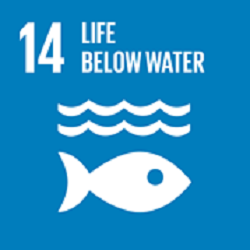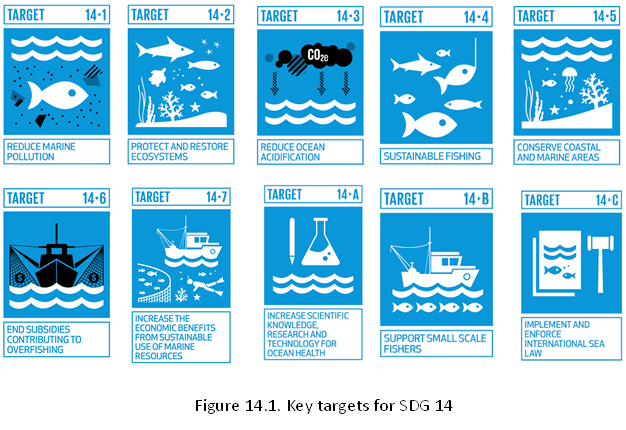Sustainable Development Goal (SDG 14): ‘Life below water’ - Preserving and protecting the oceans and seas and the life within them is a vital task for engineers
By Eng. (Dr.) Saja A. A. Majeed
 Sri Lanka has a coastline that extends over 1,700 km, with numerous coastal and marine ecosystems, which include a variety of economic activities such as fisheries and aquaculture, tourism and ports and shipping. Such economic activities provide livelihood for more than 300,000 people through fisheries and around another 350,000 people get their jobs in the coastal tourism industry. The interventions to harness the ‘blue economy’ or ‘ocean-based economy’ opportunities need to be optimised with a ‘do no harm’ approach to the water-based ecosystems.
Sri Lanka has a coastline that extends over 1,700 km, with numerous coastal and marine ecosystems, which include a variety of economic activities such as fisheries and aquaculture, tourism and ports and shipping. Such economic activities provide livelihood for more than 300,000 people through fisheries and around another 350,000 people get their jobs in the coastal tourism industry. The interventions to harness the ‘blue economy’ or ‘ocean-based economy’ opportunities need to be optimised with a ‘do no harm’ approach to the water-based ecosystems.
Every SDG needs engineers. How can engineers contribute to attain Sustainable Development Goal (SDG) 14 – ‘Life below water’, which is to conserve and sustainably use the oceans, seas and marine resources for sustainable development. Oceans, seas and coastal areas create an integrated and vital component of the earth’s ecosystem and are critical to sustainable development. However, increased human activities greatly threaten and destroy these water bodies and livings. In this context, engineers contribute in developing many built environment facilities for promoting sustainable tourism, which will help to reduce the coastal pollution.
Further to the current maritime activities such as fishing, shipping, and tourism, engineers can play a key role in exploring innovative energy generation methods from the sea, for which the research efforts to identify the most promising areas for optimum advantages are still at the primitive stages in Sri Lanka (Lokuliyana 2019). Sri Lanka being an island, adopting a ‘Blue Economy’ strategy is not optional but mandatory for Sri Lanka, which has many advantages (Senaratne 2017), while a number of challenges to strike a fair balance between the benefits for human and water livings.
More than 80% of world merchandise trade by volume is carried by sea and marine traffic in the sea lanes around Sri Lankan water has been increasing. Several incidents of oil/chemical spills and marine accidents have been reported from near-shore areas of Sri Lankan water from time to time. The recent fire on the MV X-Press Pearl is the worst ever marine disaster in the Sri Lankan waters, an example of impending threats to marine and coastal livings. Further, marine and coastal environments are increasingly getting polluted not only due to ocean-based pollutants, but also land-based pollutants in the coastal areas. The oceans around the world have also become the largest waste dumping sites globally.
Global key figures related to ‘Life below water’ (SDG14)
Some of the relevant global key figures related to ‘Life below water’ provided in the United Nation statistics include (https://sdgs.un.org/goals/goal14):
- More than three billion people rely on the ocean for their livelihoods
- More than 80% of world merchandise trade by volume is carried by sea
- Mean protected area coverage of marine Key Biodiversity Areas increased globally from 28% in 2000 to 44% in 2020
- Sustainable fisheries accounted for approximately 0.1% of global GDP in 2017, while in certain regions they contributed to more than 0.5% of GDP
SDG 14 (Life below water) targets
SDG 14 sets out seven key targets and three additional targets (14.a, 14.b, and 14.c) for resource mobilisation and policy to be achieved by 2030. The ten key targets are:
14.1. By 2025, prevent and significantly reduce marine pollution of all kinds, in particular from land-based activities, including marine debris and nutrient pollution
14.2. By 2020, sustainably manage and protect marine and coastal ecosystems to avoid significant adverse impacts, including by strengthening their resilience, and take action for their restoration in order to achieve healthy and productive oceans
14.3. Minimize and address the impacts of ocean acidification, including through enhanced scientific cooperation at all levels
14.4. By 2020, effectively regulate harvesting and end overfishing, illegal, unreported and unregulated fishing and destructive fishing practices and implement science-based management plans, in order to restore fish stocks in the shortest time feasible, at least to levels that can produce maximum sustainable yield as determined by their biological characteristics
14.5. By 2020, conserve at least 10 percent of coastal and marine areas, consistent with national and international law and based on the best available scientific information
14.6. By 2020, prohibit certain forms of fisheries subsidies which contribute to overcapacity and overfishing, eliminate subsidies that contribute to illegal, unreported and unregulated fishing and refrain from introducing new such subsidies, recognizing that appropriate and effective special and differential treatment for developing and least developed countries should be an integral part of the World Trade Organization fisheries subsidies negotiation
14.7. By 2030, increase the economic benefits to Small Island developing States and least developed countries from the sustainable use of marine resources, including through sustainable management of fisheries, aquaculture and tourism
14.a. Increase scientific knowledge, develop research capacity and transfer marine technology, taking into account the Intergovernmental Oceanographic Commission Criteria and Guidelines on the Transfer of Marine Technology, in order to improve ocean health and to enhance the contribution of marine biodiversity to the development of developing countries, in particular small island developing States and least developed countries
14.b. Provide access for small-scale artisanal fishers to marine resources and markets
14.c. Enhance the conservation and sustainable use of oceans and their resources by implementing international law as reflected in UNCLOS, which provides the legal framework for the conservation and sustainable use of oceans and their resources
 Detail indicator descriptions are available at https://unstats.un.org/sdgs
Detail indicator descriptions are available at https://unstats.un.org/sdgs
SDG 14 (Life below water) target indicators (examples)
The achievement of ‘Life below water’ goal is measured by the following set of key indicators:
- Index of coastal eutrophication and floating plastic debris density
- Proportion of national exclusive economic zones managed using ecosystem-based approaches
- Average marine acidity (pH) measured at agreed suite of representative sampling stations
- Proportion of fish stocks within biologically sustainable levels
- Coverage of protected areas in relation to marine areas
- Progress by countries in the degree of implementation of international instruments aiming to combat illegal, unreported and unregulated fishing
- Sustainable fisheries as a percentage of GDP in small island developing States, least developed countries and all countries
- Proportion of total research budget allocated to research in the field of marine technology
- Progress by countries in the degree of application of a legal/regulatory/policy/institutional framework which recognizes and protects access rights for small-scale fisheries
- Number of countries making progress in ratifying, accepting and implementing through legal, policy and institutional frameworks, ocean-related instruments that implement international law, as reflected in the United Nation Convention on the Law of the Sea, for the conservation and sustainable use of the oceans and their resources
Current status of SDG 14 progression in Sri Lanka
The current status of achieving SDG 14 in Sri Lanka was reported in the recent review by the Government of Sri Lanka (SLVNR 2018). Some of the key contributions include:
- Sri Lanka has a number of legislative frameworks for sustainable management of marine (and coastal resources) namely; Fisheries and Aquatic Resources Act of 1996 (Department of Fisheries and Aquatic Resources), Coast Conservation Act of 1981 (Coast Conservation and Coastal Resources Management Department), Marine Pollution Prevention Act of 1981 (Marine Environment Protection Authority), Fauna and Flora Protection Ordinance of 1937 (Department of Wildlife Conservation) and Sri Lanka Coast Guard Act of 2009 (Sri Lanka Coast Guard)
- A number of national policies and plans have been drafted. These include the National Fisheries and Aquaculture Policy, the National Wildlife Policy of 2000, the National Biosafety Policy of 2005, the Coastal Zone and Coastal Resource Management Plan (2016), the National Oil Spill Contingency Plan of 2005, and the National Biodiversity Strategic Action Plan 2016-2022
- Risks of marine pollution through oil spills, marine accidents, and issues of biosafety are expected to increase as a result of increased shipping and fishing activities around the Sri Lankan water
- Government has been implementing required regulatory measures such as registering boats, issuing licenses, controlling uses of harmful fishing gear and promoting participation of fishers’ organizations in management of local fisheries to prevent over-exploitation of water resources
- Although Sri Lanka has many legal frameworks and policies to conserve the marine and coastal resource, the surveillance, monitoring and enforcement of legal and regulatory measures underpinning efficient policy implementation have been a continuous struggle for the local authorities.
Role of engineering to advance SDG 14 - ‘Life below water’
Some selected examples from world reputed engineering organizations are provided below briefly:
- Marine engineers are working with scientists and other engineering disciplines to implement solutions to address the degradation of fisheries, the pollution of oceans and the use of resources, including wave energy and oil and gas exploration. For example, engineers are working on a clean-up solution for the Great Pacific Garbage Patch, which comprises approximately 80,000 tonnes of plastic waste. Engineering plays a vital role in analysing the micro-plastics and exploring feasible solutions to plastic waste that threaten the marine life (UNESCO 2021)
- The Australian and Queensland governments prepared the Reef 2050 Long-Term Sustainability Plan, Australia’s overarching strategy for protecting and managing the Great Barrier Reef. A key principle of the plan is developing reef resilience for changing climate. Engineers help the implementation of this plan by improving water quality, maintaining biodiversity and ensuring port development and shipping have minimal impact on the Reef (www.gov.au 2021)
- Students from the University College London (UCL), Faculty of Engineering spent their summer developing a solution to improve the health of the world’s oceans by designing and building prototypes. A self-recycling bin, which scans and sorts rubbish to improve rates of plastic recycling, and a beach cleaning app that rewards people for collecting waste are such examples (UCL 2021)
Next SDG: SDG 15 - Life on land
In the next issue of digital SLEN, we will continue with the snapshot of SDG 15: “Life on land ‘’. All SDGs are well connected, and thus require a holistic view to address real development challenges. Until then, let us reflect on SDG 14: ‘Life below water’ and its central role in the Engineering sector and profession. Your comments on how we as engineers can contribute to achieve SDGs can be posted in the IESL Facebook page https://www.facebook.com/IESLSriLanka/.
References
- https://unstats.un.org/sdgs/indicators/Global%20Indicator%20Framework%20after%202019%20refinement_Eng.pdf
- https://country-profiles.unstatshub.org/lka#goal-13
- Sri Lanka Voluntary National Review (SLVNR) on the Status of Implementing Sustainable Development Goals, 2018. Ministry of Sustainable Development, Wildlife and Regional Development, Published by the Ministry of Sustainable Development, Wildlife and Regional Development in June, 2018.
- UNESCO (2021) United Nations Educational, Scientific and Cultural Organization, Engineering for Sustainable Development - Delivering on the Sustainable Development Goals, March 2021, https://unesdoc.unesco.org/ark:/48223/pf0000375644/PDF/375644eng.pdf.multi
- https://dashboards.sdgindex.org/static/countries/profiles/Sri%20Lanka.pdf
- https://wec2019.org.au/2019/09/05/every-sustainable-development-goals-needs-engineers/
- Lokuliyana, R. L. K., Folley, M., Gunawardane, S. D. G. S. P., & Wickramanayake, P. N. (2019). Importance of Developing a Sri Lankan Wave Energy Resource Assessment According to IEC Standards. In National Energy Symposium 2019 (p. 128).
- Athula Senaratne (2017) Oceans and Sri Lanka’s future: Towards a blue economy https://www.ips.lk/wp-content/uploads/2017/03/FT_07June_Oceans-and-Sri-Lanka%E2%80%99s-future.pdf
- https://www.environment.gov.au/marine/gbr/publications/reef-2050-long-term-sustainability-plan-2018
- https://www.ucl.ac.uk/sustainable-development-goals/case-studies/2020/oct/tackling-oceans-plastic-problem-through-engineering
 Eng. (Dr.) Saja A.A. Majeed
Eng. (Dr.) Saja A.A. Majeed
BscEng, MScEng, PhD
Lecturer
Faculty of Engineering
South Eastern University of Sri Lanka





